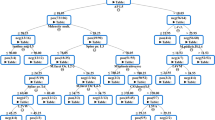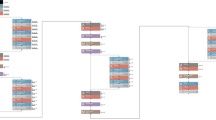Abstract
The scope of this study is to diagnose vertebral arterial inefficiency by using Doppler measurements from both right and left vertebral arterials. Total of 96 patients’ Doppler measurements, consisting of 42 of healthy, 30 of spondylosis, and 24 of clinically proven vertebrobasillary insufficiency (VBI), were examined. Patients’ age and sex information as well as RPSN, RPSVN, LPSN, LPSVN, and TOTALVOL medical parameters obtained from vertebral arterials were classified by neural networks, and the performance of said classification reached up to 93.75% in healthy, 83.33% in spondylosis, and 97.22% in VBI cases. The area under ROC curve, which is a direct indication of repeating success ratio, is calculated as 92.3%, and the correlation coefficient of the classification groups is 0.9234. It is also demonstrated that those medical parameters of age and systolic velocity, which were applied into the neural networks, were more effective in developing vertebral deficiency.
Similar content being viewed by others
References
Seidel, E., Eicke, B. M., Tettenborn, B., and Krummenauer, F., Reference values for vertebral artery flow volume by duplex sonography in young and elderly adults. Stroke 30:2692–2696, 1999.
Nakamura, K., Saku, Y., Torigoe, R., Ibayashi, S., and Fujishima, M., Sonographic detection of hemodynamic changes in a case of vertebrobasilar insufficiency. Neuroradiology 40:164–166, 1998.
Scheel, P., Ruge, C., Petruch, U. R., and Schoning, M., Color duplex measurement of cerebral blood flow volume in healthy adults. Stroke 31:147–150, 2000.
Jargiello, T., Pietura, R., Rakowski, P., Trojanowska, M. S., Szajner, M., and Janczarek, M., Power Doppler imaging in the evaluation of extracranial vertebral artery compression in patients with vertebrobasilar insufficiency. Eur. J. Ultrasound 8:149–156, 1998.
Shin, J. H., Suh, D. C., Choi, C. G., and Leei, H. K., Vertebral artery dissection: Spectrum of imaging findings with emphasis on angiography and correlation with clinical presentation. Radiographics 20:1687–1696, 2000.
Caphan, L. R., Migrain and vertebrobasilar ischemia. Neurology 41:55–61, 1991.
Janes, A. L., Carl, E., and Jeffrey, P. E., Vertebrobasilar insufficiency. Arch. Neural 42:803–808, 1985.
Haynes, M. J., and Milne, N., Color duplex sonographic findings in human vertebral arteries during cervical rotation. J. Clin. Ultrasound 29:14–24, 2001.
Scheel, P., Ruge, C., and Schoning, M., Flow velocity and flow volume measurements in the extracranial carotid and vertebral arteries in healthy adults: Reference data and the effects of age. Ultrasound Med. Biol. 26:1261–1266, 2000.
Horwich, T. B., Fonarow, G. C., Hamilton, M. A., MacLellan, W. R., Woo, M. A., and Tillisch, J. H., The relationship between obesity and mortality in patients with heart failure. J. Am. Coll. Cardiol. 38:789–795, 2001.
Beale, R., and Jackson, T., Neural Computing: An Introduction, Institute of Physics, Bristol, UK, 1990.
Fredric, M. H., and Inica, K., Principles of Neurocomputing for Science and Engineering, McGraw-Hill, New York, 2001.
White, H., Learning in artificial neural networks: A statistical approach. Neural Comput. 1:425–464, 1989.
Baxt, W. G., Application of neural networks to clinical medicine. Lancet 346:1135–1138, 1995.
Mobley, B. A., Schecter, E., Moore, W. E., McKee, P. A., and Eichner, J. E., Predictions of coronary artery stenosis by artificial neural network. Artif. Intell. Med. 18:187–203, 2000.
Serhatlioglu, S., Hardalaç, F., and Güler, I., Classification of transcranial Doppler signals using artificial neural network. J. Med. Syst. 27(2):205–214, 2003.
Şeker, H., Evans, D. H., Aydin, N., and Yazgan, E., Compensatory fuzzy neural networks-based intelligent detection of abnormal neonatal cerebral Doppler ultrasound waveforms. IEEE Trans. Inf. Technol. Biomed. 5(3):187–194, 2001.
Guler, İ., Hardalaç, F., and Barisci, N., Application of FFT analyzed cardiac Doppler signals to fuzzy algorithm. Comput. Biol. Med. 32:435–444, 2002.
Abdel-Aal, R. E., and Mangoud, A. M., Modeling obesity using abductive networks. Comput. Biomed. Res. 30:451–471, 1997.
Haykin, S., Neural Network: A Comprehensive Foundation, Prentice-Hall, Upper Saddle River, NJ, 1999.
Hanley, J. A., and McNeil, B. J., The meaning and use of the area under the receiver operating characteristic (ROC) curve. Radiology 143:29–36, 1982.
Author information
Authors and Affiliations
Corresponding author
Rights and permissions
About this article
Cite this article
Özdemir, H., Berilgen, M.S., Serhatlıoğlu, S. et al. Examination of the Effects of Degeneration on Vertebral Artery by Using Neural Network in Cases With Cervical Spondylosis. J Med Syst 29, 91–101 (2005). https://doi.org/10.1007/s10916-005-2998-2
Issue Date:
DOI: https://doi.org/10.1007/s10916-005-2998-2




